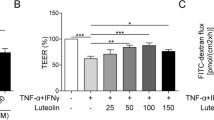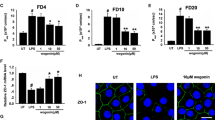Abstract
Background
In liver cirrhosis, intestinal mucus barrier is rarely studied.
Aims
This study aimed to investigate whether mucus barrier in ileum is altered in cirrhotic rats and its underlying mechanisms.
Methods
Thioacetamide was injected to induce liver cirrhosis in rats. Serum from portal vein blood, and ileum and liver tissues were obtained for further analysis. Goblet cell-like Ls174T cells were cultured for in vitro experiments.
Results
The ileal mucus was thin, loose, and porous with small bubbles in cirrhotic rats. mRNA expressions of Muc2 and TFF3 were also down-regulated in cirrhotic rats. Bacteria located near to crypts and LPS were increased in the serum from portal vein in cirrhotic rats. Smaller theca area and few goblet cells were found in cirrhotic rats compared with control. Increased proliferation of ileal epithelia was observed in cirrhotic rats. Notch1, Dll1, and Hes1 expressions were enhanced, and KLF4 expression was suppressed in ileum of cirrhotic rats. In Ls174T cells, EDTA and NICD plasmid induced NICD and Hes1 expression and suppressed KLF4 concomitantly, and mucus expression almost vanished in these cells. NICD plasmid induced more proliferation in Ls174T cells. Oppositely, after DBZ treatment, NICD and Hes1 were inhibited along with augmentation of KLF4 and increased mucous expression in Ls174T cells, while proliferation of the cells was suppressed.
Conclusions
In cirrhotic rats, mucus barrier was impaired. This might be attributed to increased proliferation and decreased differentiation of epithelia, which might be mediated by Notch1–Hes1–KLF4 signaling.






Similar content being viewed by others
References
Mokdad AA, Lopez AD, Shahraz S, et al. Liver cirrhosis mortality in 187 countries between 1980 and 2010: a systematic analysis. BMC Med. 2014;12:145.
Bartoletti M, Giannella M, Lewis RE, Viale P. Bloodstream infections in patients with liver cirrhosis. Virulence. 2016;7:309–319.
Fukui H. Gut-liver axis in liver cirrhosis: how to manage leaky gut and endotoxemia. World J Hepatol. 2015;7:425–442.
Wiest R, Albillos A, Trauner M, Bajaj JS, Jalan R. Targeting the gut-liver axis in liver disease. J Hepatol. 2017;67:1084–1103.
Turner JR. Intestinal mucosal barrier function in health and disease. Nat Rev Immunol. 2009;9:799–809.
Sorribas M, Jakob MO, Yilmaz B, et al. FXR-modulates the gut-vascular barrier by regulating the entry sites for bacterial translocation in experimental cirrhosis. J Hepatol. 2019;71:1126–1140.
Johansson ME, Hansson GC. Immunological aspects of intestinal mucus and mucins. Nat Rev Immunol. 2016;16:639–649.
Pelaseyed T, Bergstrom JH, Gustafsson JK, et al. The mucus and mucins of the goblet cells and enterocytes provide the first defense line of the gastrointestinal tract and interact with the immune system. Immunol Rev. 2014;260:8–20.
Van der Sluis M, De Koning BA, De Bruijn AC, et al. Muc2-deficient mice spontaneously develop colitis, indicating that MUC2 is critical for colonic protection. Gastroenterology. 2006;131:117–129.
Hasnain SZ, Wang H, Ghia JE, et al. Mucin gene deficiency in mice impairs host resistance to an enteric parasitic infection. Gastroenterology. 2010;138:1763–1771.
Bergstrom KS, Kissoon-Singh V, Gibson DL, et al. Muc2 protects against lethal infectious colitis by disassociating pathogenic and commensal bacteria from the colonic mucosa. PLoS Pathog. 2010;6:e1000902.
Huan YW, Bengtsson RJ, MacIntyre N, et al. Lawsonia intracellularis exploits beta-catenin/Wnt and Notch signalling pathways during infection of intestinal crypt to alter cell homeostasis and promote cell proliferation. PLoS One. 2017;12:e0173782.
Pope JL, Bhat AA, Sharma A, et al. Claudin-1 regulates intestinal epithelial homeostasis through the modulation of Notch-signalling. Gut. 2014;63:622–634.
McCauley HA, Guasch G. Three cheers for the goblet cell: maintaining homeostasis in mucosal epithelia. Trends Mol Med. 2015;21:492–503.
Kopan R, Ilagan MX. The canonical Notch signaling pathway: unfolding the activation mechanism. Cell. 2009;137:216–233.
Ueo T, Imayoshi I, Kobayashi T, et al. The role of Hes genes in intestinal development, homeostasis and tumor formation. Development. 2012;139:1071–1082.
Pellegrinet L, Rodilla V, Liu Z, et al. Dll1- and dll4-mediated notch signaling are required for homeostasis of intestinal stem cells. Gastroenterology. 2011;140:e1231–e1237.
Zheng H, Pritchard DM, Yang X, et al. KLF4 gene expression is inhibited by the notch signaling pathway that controls goblet cell differentiation in mouse gastrointestinal tract. Am J Physiol Gastrointest Liver Physiol. 2009;296:G490–G498.
Gregorieff A, Stange DE, Kujala P, et al. The ets-domain transcription factor Spdef promotes maturation of goblet and paneth cells in the intestinal epithelium. Gastroenterology. 2009;137:e1331–e1333.
McGuckin MA, Hasnain SZ. There is a ‘uc’ in mucus, but is there mucus in UC? Gut. 2014;63:216–217.
Johansson ME, Gustafsson JK, Holmen-Larsson J, et al. Bacteria penetrate the normally impenetrable inner colon mucus layer in both murine colitis models and patients with ulcerative colitis. Gut. 2014;63:281–291.
Zheng X, Tsuchiya K, Okamoto R, et al. Suppression of hath1 gene expression directly regulated by hes1 via notch signaling is associated with goblet cell depletion in ulcerative colitis. Inflamm Bowel Dis. 2011;17:2251–2260.
Wang A, Li J, Zhao Y, Johansson ME, Xu H, Ghishan FK. Loss of NHE8 expression impairs intestinal mucosal integrity. Am J Physiol Gastrointest Liver Physiol. 2015;309:G855–G864.
Iwao T, Toyonaga A, Ikegami M, et al. Gastric mucus generation in cirrhotic patients with portal hypertension. Effects of tetraprenylacetone. Dig Dis Sci. 1996;41:1727–1732. https://doi.org/10.1007/bf02088737.
Imanishi H, Harihara Y, Bandai Y, Sanjo K, Makuuchi M. Reduced gastric surface mucus layer in experimental portal hypertension. J Gastroenterol. 1997;32:720–725.
Yu H, He Y, Zhang X, et al. The rat IgGFcgammaBP and Muc2 C-terminal domains and TFF3 in two intestinal mucus layers bind together by covalent interaction. PLoS One. 2011;6:e20334.
De Lisle RC, Roach E, Jansson K. Effects of laxative and N-acetylcysteine on mucus accumulation, bacterial load, transit, and inflammation in the cystic fibrosis mouse small intestine. Am J Physiol Gastrointest Liver Physiol. 2007;293:G577–G584.
Fre S, Huyghe M, Mourikis P, Robine S, Louvard D, Artavanis-Tsakonas S. Notch signals control the fate of immature progenitor cells in the intestine. Nature. 2005;435:964–968.
VanDussen KL, Carulli AJ, Keeley TM, et al. Notch signaling modulates proliferation and differentiation of intestinal crypt base columnar stem cells. Development. 2012;139:488–497.
Suzuki K, Fukui H, Kayahara T, et al. Hes1-deficient mice show precocious differentiation of Paneth cells in the small intestine. Biochem Biophys Res Commun. 2005;328:348–352.
Katz JP, Perreault N, Goldstein BG, et al. The zinc-finger transcription factor Klf4 is required for terminal differentiation of goblet cells in the colon. Development. 2002;129:2619–2628.
Ghaleb AM, McConnell BB, Kaestner KH, Yang VW. Altered intestinal epithelial homeostasis in mice with intestine-specific deletion of the Kruppel-like factor 4 gene. Dev Biol. 2011;349:310–320.
Gui X, Meng Z, McConnell YJ, et al. Differing expression profiles of Notch/enterocyte and Wnt/secretory lineage signallings are associated with morphological diversity of appendiceal tumours. J Clin Pathol. 2017;70:40–50.
Ghaleb AM, Aggarwal G, Bialkowska AB, Nandan MO, Yang VW. Notch inhibits expression of the Kruppel-like factor 4 tumor suppressor in the intestinal epithelium. Mol Cancer Res. 2008;6:1920–1927.
Rand MD, Grimm LM, Artavanis-Tsakonas S, et al. Calcium depletion dissociates and activates heterodimeric notch receptors. Mol Cell Biol. 2000;20:1825–1835.
Acknowledgments
This study was supported by the National Natural Science Foundation of China (U1702281, 81670551, and 81873584), the Chinesisch-Deutsches Zentrum fṻr Wissenschaftsfὅrderung (GZ1065), the Science and Technology Support Program of Sichuan Province (2016SZ0041), the Science and Technology Department of Sichuan Province (20YYJC3383), the National Key R&D Program of China (2017YFA0205404), the China Postdoctoral Science Foundation Grant (2019M653436), the and Post-Doctor Research Project, West China Hospital, Sichuan University (2019HXBH013). All the listed Grants support the expenses of performing experiments. No assistance with manuscript preparation was done.
Author information
Authors and Affiliations
Corresponding author
Ethics declarations
Conflict of interest
The authors declare that they have no conflict of interest.
Human and animal rights
The animal experimentation was approved by institutional ethics committees. All procedures performed in studies involving animals were in accordance with the ethical standards of the institution or practice at which the studies were conducted.
Additional information
Publisher's Note
Springer Nature remains neutral with regard to jurisdictional claims in published maps and institutional affiliations.
Electronic supplementary material
Below is the link to the electronic supplementary material.
Rights and permissions
About this article
Cite this article
Zhang, L., Tai, Y., Tang, S. et al. Compromised Ileal Mucus Barrier Due to Impaired Epithelial Homeostasis Caused by Notch1 Signaling in Cirrhotic Rats. Dig Dis Sci 66, 131–142 (2021). https://doi.org/10.1007/s10620-020-06178-6
Received:
Accepted:
Published:
Issue Date:
DOI: https://doi.org/10.1007/s10620-020-06178-6




